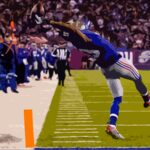American Football is considered a highly physical and dangerous professional sport.
The NFL and particularly college football have made various changes to their rulebook to lessen the yearly injury count.
The main focus has been to reduce head-type injuries, including spinal injuries and concussions.
Given the nature of the game, there’ve been existing rules in place for plays such as unnecessary roughness and face mask violations.
Unnecessary roughness is essentially a late or vicious hit possibly to an unexpected player.
And you can easily understand that grabbing and twisting of the face mask would put pressure on the recipient’s head and neck.
But the rate of head and neck injuries have still been considerably high in relation to other sports and the league was asked clamp down further.
One of the rules introduced back in 2008 is known as Targeting.
The result of the play may not only lead to an opposing player injury, but to the aggressor as well.
What is Targeting in Football?
In football, targeting occurs when a defensive player intentionally makes a forceful hit, usually with the crown of their helmet, to an opponent's head or neck area. It’s considered as an attack with forcible contact that goes beyond making a legal block, tackle or play on the ball. This rule underscores commitment to player safety and reducing dangerous hits.
As of today, targeting is treated differently in college football than it is in the National Football League.
If targeting is called in a college game, the offender is automatically ejected from the remainder of the game.
Should the call be made in the second half, the player will be suspended for the first half of the subsequent game.
Meanwhile, the play, itself, results in a 15-yard penalty and an automatic first down.
In the NFL, targeting doesn’t warrant an automatic game ejection, but may be reviewed by the league commissioner for further discipline.
If the targeting contact is deemed excessive, the player can end up with a fine or suspension.
Can Targeting Calls be Reviewed or Challenged?
Targeting calls can be reviewed in many college football and NFL games.
The introduction of replay review for targeting plays is a significant development aimed at ensuring the accuracy of such crucial decisions.
When a targeting foul is called on the field, it initiates a review process.
Automatic Review
In most cases, targeting calls are subject to automatic review by the replay officials.
The replay booth examines various camera angles and replays to determine whether the criteria for targeting are met.
Confirmation or Overturn
The replay officials have the authority to confirm or overturn the targeting call based on their assessment of the video evidence.
If the evidence supports the call, the player is ejected, and the 15-yard penalty is enforced.
However, if the evidence shows that the call was incorrect or that the player's actions did not meet the targeting criteria, the call is overturned, and the player remains in the game.
Penalty Still Applies
Even if a targeting call is overturned, the 15-yard penalty assessed on the field remains in place. This means that the team's opponent still benefits from the penalty yardage.
Replay review for targeting plays serves as an essential tool in maintaining player safety and ensuring the fairness of these significant in-game decisions.
For NCAA games, it helps prevent wrongful ejections and ensures that only plays that genuinely meet the criteria for targeting result in player ejections.
Examples of Targeting
| Indicator | Description |
|---|---|
| Leaving feet to attack | Player leaves their feet, making an upward and forward thrust to forcibly hit the head or neck area of an opponent. |
| Crouch with upward thrust | A player crouches and then thrusts upward and forward, targeting the head or neck area with forcible contact, even if one or both feet remain on the ground. |
| Leading with various body parts | A player leads with their helmet, shoulder, forearm, fist, hand, or elbow, aiming to make forcible contact at the opponent's head or neck area. |
| Lowering head with the crown of the helmet | A player lowers their head and initiates forcible contact using the crown of the helmet, targeting the head or neck area of an opponent. |
Final Thoughts
For the last two decades, there’s been a heightened concern in athletes developing CTE (Chronic traumatic encephalopathy).
The brain disorder is mainly associated with repeated hits to the head, which is why professional athletes are most prone to developing.
Many former NFL players have pledged or donated their brains for research. They can only be studied posthumously (after death).
The belief is that concussed players suffer damage from the original hit, but can make matters worse if hit again before recovering.
Which is why you’ll see players sidelined for at least 7-10 days or even more.
By chipping away at certain types of hits such as targeting, the NFL and other leagues hope to reduce head injuries.
The leagues have not only targeted direct hits, but sequences that lead to head injuries.
For example, the NFL kickoff is considered the most dangerous play and the league changed their touchback rule to reduce concussion rates by an estimated 15%.
That is, the receiving team can call a fair catch anywhere before the 25-yard line.
This is meant to encourage less rushes on the kickoff where both sides are running towards each other at high speeds.
Let’s hope that every football league can meet their target, while keeping the game exciting for the fans.






